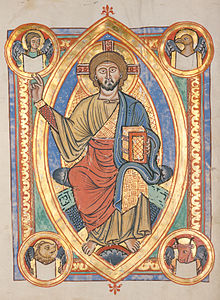The World (tarot card)

The World (XXI) is a trump or Major Arcana card in the tarot deck. It is usually the final card of the Major Arcana or tarot trump sequence. In the tarot family of card games, this card is usually worth five points.
Description

A naked woman hovers or dances above the Earth holding a staff in each hand, surrounded by a green wreath, being watched by various creatures. In older decks, these are usually a tetramorph, a human face or head, a lion, an ox, and an eagle, the symbols of the four Evangelists. The four figures in the corners of the card are also referenced in the Book of Revelation, 4:7, where the throne of God is described: "And the first beast was like a lion, and the second beast like a calf, and the third beast had a face as a man, and the fourth beast was like a flying eagle."
Later decks avoid such overt Christian symbolism, or ignore it altogether, choosing to explain these observers as representatives of the natural world, or the kingdom of beasts. According to astrological tradition, the Lion is Leo, a fire sign; the Bull or calf is Taurus, an earth sign; the Man is Aquarius, an air sign; and the Eagle is Scorpio, a water sign.[1] These signs also represent the classical four elements.
In some decks the wreath is an ouroborous biting its own tail. In the Thoth Tarot designed by Aleister Crowley, this card is called "The Universe."
Interpretation
The World represents an ending to a cycle of life, a pause in life before the next big cycle beginning with the fool.[2] The figure is at once male and female, above and below, suspended between the heavens and the earth. It is completeness. It is also said to represent cosmic consciousness; the potential of perfect union with the One Power of the universe.[3] It tells us full happiness is also to give back to the world, sharing what we have learned or gained.
According to Robert M. Place in his book The Tarot,[4] the four beasts on the World card represent the fourfold structure of the physical world, which frames the sacred center of the world, a place where the divine can manifest. Sophia, meaning Prudence or Wisdom (the dancing woman in the center), is spirit or the sacred center, the fifth element. It is the fourth of the Cardinal virtues in the Tarot.[4] The lady in the center is thus a symbol of the goal of mystical seekers. In some older decks, this central figure is Christ, in others it is Hermes. Whenever it comes up, this card represents what is truly desired.[5]
In Popular Culture
- The World is the name of the final boss in The House of the Dead 4 videogame by Sega. At the start of the battle it takes the form of a giant, crystal, moth-like creature with cryokinetic abilities; however, it swiftly evolves into a more dangerous angel-like monster during the fight. At the moment of its final defeat it attempts to transform into an apocalyptic superweapon, fitting the older artwork of its namesake card. All of the bosses in the The House of the Dead series (with the exception of The House of the Dead: Overkill) are named after the Major Arcana cards.
- The main antagonist of the first and third parts of JoJo's Bizarre Adventure, Dio Brando, has a Stand called The World, named after this card. In addition to possessing super strength and speed, its signature ability is stopping time.
- Along with other Major Arcana, the World is a playable character in Data East's puzzle video game series, Magical Drop.
- The World card, along with the other Tarot cards of the Major Arcana, appears in the 2011 video game, The Binding of Isaac, and its 2014 remake, The Binding of Isaac: Rebirth, where they act as consumable items with varying effects. The World fills in the player's map of the current dungeon.
- The World card appears in the video game Persona 4, where the protagonist receives the card after his persona, Izanagi, evolves to Izanagi-no-Okami.
References
Bibliography
- Case, Paul Foster (1947). The Tarot. Builders of the Adytum.
- DeVore, Nicholas (1947). Encyclopedia of Astrology. Philosophical Library.
- Place, Robert M. (2005). The Tarot: History, Symbolism and Divination. New York: Jeremy P. Tarcher/Penguin. ISBN 1-58542-349-1.
- Waite, Arthur (1911). The Pictorial Key to the Tarot. London: W. Rider.
- Wood, Juliette (1998). "The Celtic Tarot and the Secret Tradition: A Study in Modern Legend Making". Folklore. 109: 15–24. doi:10.1080/0015587x.1998.9715957.
External links
- The World -"fulfillment and completeness"- how to interpret this card
